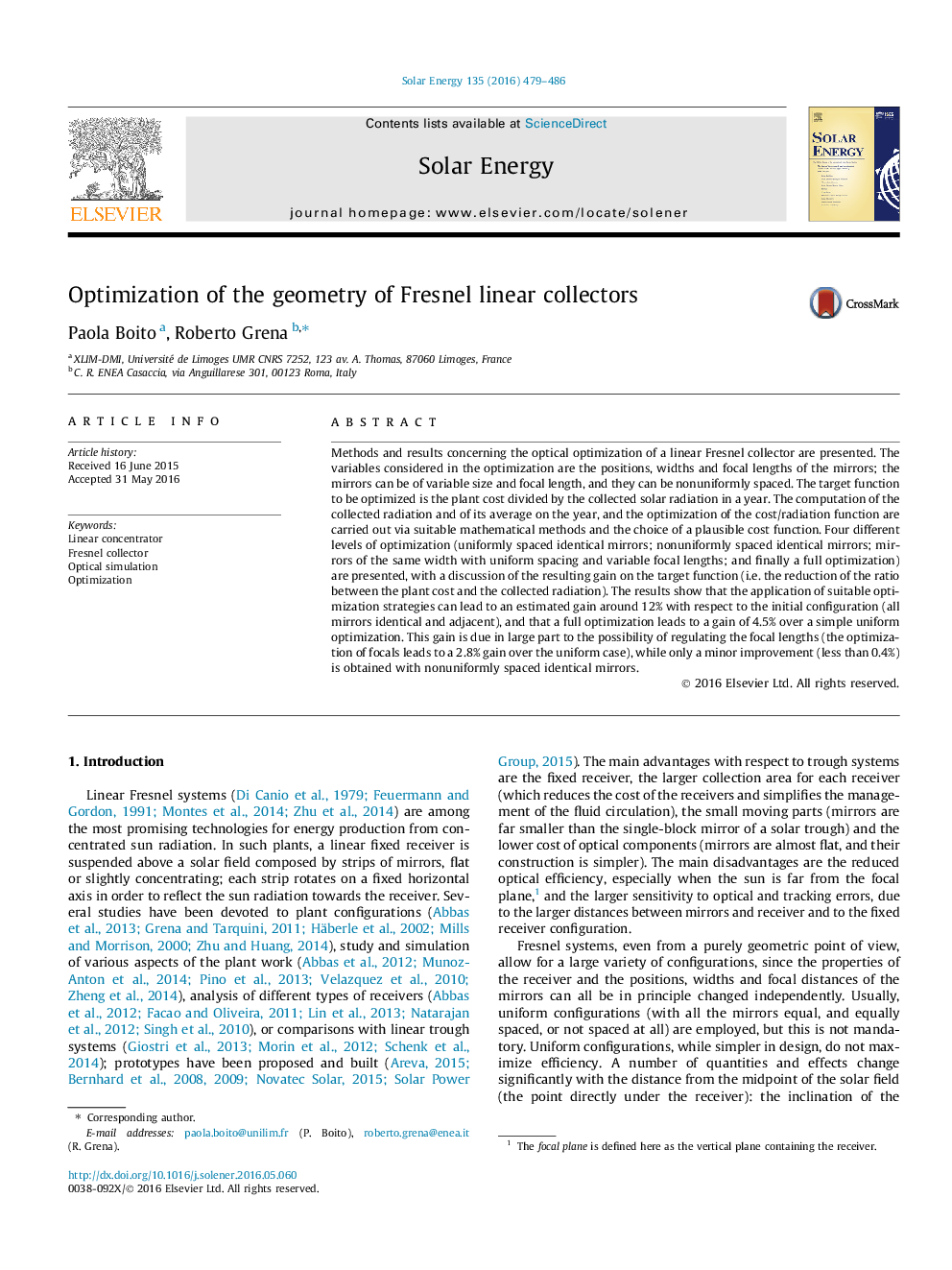| کد مقاله | کد نشریه | سال انتشار | مقاله انگلیسی | نسخه تمام متن |
|---|---|---|---|---|
| 7936781 | 1513083 | 2016 | 8 صفحه PDF | دانلود رایگان |
عنوان انگلیسی مقاله ISI
Optimization of the geometry of Fresnel linear collectors
ترجمه فارسی عنوان
بهینه سازی هندسه جمع کننده خطی فرنل
دانلود مقاله + سفارش ترجمه
دانلود مقاله ISI انگلیسی
رایگان برای ایرانیان
کلمات کلیدی
غلظت خطی، جمع کننده فرسل، شبیه سازی نوری، بهینه سازی،
ترجمه چکیده
روشها و نتایج مربوط به بهینه سازی نوری یک جمع کننده خطی فرسن ارائه شده است. متغیرهایی که در بهینه سازی در نظر گرفته می شوند، موقعیت، عرض و طول کانونی آینه ها هستند. آینه ها می توانند از اندازه متغیر و فاصله کانونی باشند و می توانند به طور غیرمستقیم فاصله یابند. تابع هدف بهینه سازی شده است هزینه گیاه تقسیم شده توسط تابش خورشیدی جمع شده در یک سال است. محاسبه تابش جمع آوری شده و میانگین آن در سال و بهینه سازی تابع هزینه / تابش با استفاده از روش های مناسب ریاضی و انتخاب یک تابع هزینه قابل قبول انجام می شود. چهار سطح مختلف بهینه سازی (آینه های یکنواخت فاصله ای، آینه های یکسان یکنواخت، آینه های یکسان با فاصله یکنواخت و فاصله کانونی متغیر و در نهایت یک بهینه سازی کامل) ارائه شده است، با بحث در مورد نتیجه حاصل از عملکرد هدف یعنی کاهش نسبت هزینه های گیاهی و پرتو جمع آوری شده). نتایج نشان می دهد که استفاده از استراتژی های بهینه سازی مناسب می تواند منجر به افزایش تقریبا 12٪ نسبت به پیکربندی اولیه (تمام آینه های یکسان و مجاور) و بهینه سازی کامل منجر به افزایش 4.5٪ در طول یک بهینه سازی یکنواخت ساده . این افزایش در بخش مهمی از امکان تنظیم فاصله کانونی (بهینه سازی کانال ها منجر به افزایش 2.8٪ در مورد یکنواخت) می شود، در حالی که تنها یک بهبود جزئی (کمتر از 0.4٪) با آینه های یکنواخت .
موضوعات مرتبط
مهندسی و علوم پایه
مهندسی انرژی
انرژی های تجدید پذیر، توسعه پایدار و محیط زیست
چکیده انگلیسی
Methods and results concerning the optical optimization of a linear Fresnel collector are presented. The variables considered in the optimization are the positions, widths and focal lengths of the mirrors; the mirrors can be of variable size and focal length, and they can be nonuniformly spaced. The target function to be optimized is the plant cost divided by the collected solar radiation in a year. The computation of the collected radiation and of its average on the year, and the optimization of the cost/radiation function are carried out via suitable mathematical methods and the choice of a plausible cost function. Four different levels of optimization (uniformly spaced identical mirrors; nonuniformly spaced identical mirrors; mirrors of the same width with uniform spacing and variable focal lengths; and finally a full optimization) are presented, with a discussion of the resulting gain on the target function (i.e. the reduction of the ratio between the plant cost and the collected radiation). The results show that the application of suitable optimization strategies can lead to an estimated gain around 12% with respect to the initial configuration (all mirrors identical and adjacent), and that a full optimization leads to a gain of 4.5% over a simple uniform optimization. This gain is due in large part to the possibility of regulating the focal lengths (the optimization of focals leads to a 2.8% gain over the uniform case), while only a minor improvement (less than 0.4%) is obtained with nonuniformly spaced identical mirrors.
ناشر
Database: Elsevier - ScienceDirect (ساینس دایرکت)
Journal: Solar Energy - Volume 135, October 2016, Pages 479-486
Journal: Solar Energy - Volume 135, October 2016, Pages 479-486
نویسندگان
Paola Boito, Roberto Grena,
